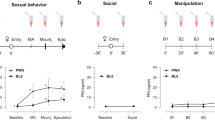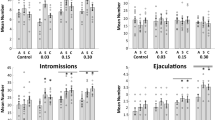Abstract
Purpose
The dopamine-derived endogenous compound, R-salsolinol (SAL), was recently identified as a putative endogenous prolactin (PRL)-releasing factor. However, how SAL influences copulatory behavior is unknown. In this study, we examined the relationship between SAL and copulatory behavior in male rats.
Methods
Male Sprague-Dawley rats administered SAL were exposed to female rats in estrus, the plasma PRL concentration was measured, and the behavioral frequency and time during copulatory behavior were noted.
Results
In the control and SAL groups, plasma PRL concentrations at 15 min before exposure to the female were 7.3 ± 2.0 and 8.0 ± 1.5 ng/ml, respectively. Moreover, plasma PRL concentrations in males immediately after exposure to the female were 7.4 ± 1.2 and 68.0 ± 5.9 ng/ml, respectively (P < 0.05). All (8/8) of the control animals ejaculated in the presence of the female, whereas only 33% (2/6) of the SAL group ejaculated. An increasing tendency for mount latency and intromission latency and a decreasing tendency for intromission frequency were observed in the SAL group.
Conclusions
Copulatory behavior was inhibited in male rats after SAL injection, suggesting that SAL is a copulatory behavior inhibiting factor.


Similar content being viewed by others
References
Weizman A, Weizman R, Hart J, et al. The correlation of increased serum prolactin levels with decreased sexual desire and activity in elderly men. J Am Geriatr Soc. 1983;31:485–8.
Kitamura M, Oka T, Okuyama A. Hyperprolactinemia and erectile dysfunction. Nippon Rinsho. 2002;60(Suppl 6):341–3 (in Japanese).
Maki A. Prolactin and male sexual dysfunction. Nippon Hinyokika Gakkai Zasshi. 1988;79:1002–10.
Tóth EB, Bodnár I, Homicskó KG, et al. Physiological role of salsolinol: its hypophysiotrophic function in the regulation of pituitary prolactin secretion. Neurotoxicol Teratol. 2002;24:655–66.
Bridges RS, DiBiase R, Loundes D. Prolactin stimulation of maternal behavior in female rats. Science. 1985;227:782–4.
Molz H, Lubin M, Leon M, et al. Hormonal induction of maternal behavior in the ovariectomized nulliparous rat. Physiol Behav. 1970;5:1373–7.
Hokao R, Saito TR, Takahashi KW. Copulatory behavior after ectopic pituitary grafting in male rats. Exp Anim. 1993;42:579–83 (in Japanese).
Homicskó KG, Keratész I, Radnai B, et al. Binding site of salsolinol: its properties in different regions of the brain and the pituitary gland of the rat. Neurochem Int. 2003;42:19–26.
Tóth EB. Salsolinol is a putative endogenous neuro-intermediate lobe prolactin-releasing factor. J Neuroendocrinol. 2001;13:1042–50.
Heimer L, Larsson K. Mating behavior of male rats after olfactory bulb lesions. Physiol Behav. 1967;2:207–9.
Kacsoh B, Veress Z, Tóth EB, et al. Bioactive and immunoreactive variants of prolactin in milk and serum of lactating rats and their pups. J Endocrinol. 1993;138:243–57.
Bodnár I, Mravec B, Kubovcakova L, et al. Stress-as well as suckling-induced prolactin release is blocked by a structural analogue of the putative hypophysiotrophic prolactin-releasing factor, salsolinol. J Neuroendocrinol. 2004;16:208–13.
Drago F, Lissandrello CO. The low-dose concept and the paradoxical effects of prolactin on grooming and sexual behavior. Eur J Pharmacol. 2000;405:131–7.
Radnai B, Mravec B, Nodnar I, et al. Pivotal role of an endogenous tetrahydroisoquinoline, salsolinol, in stress- and suckling-induced release of prolactin. Ann NY Acad Sci. 2004;1018:183–91.
Kalra SP, Simpkins JW, Luttge WG, et al. Effects on male sex behavior and preoptic dopamine neurons of hyperprolactinemia induced by MtTW 15 pituitary tumors. Endocrinology. 1983;113:2065–71.
Weber RFA, Ooms MP, Vreeburg JTM. Effect of a prolactin secreting tumour on copulatory behavior in male rats. J Endocrinol. 1982;93:223–9.
Bailey DL, Herbert J. Impaired copulatory behavior of male rats with hyperprolactinemia induced by domperidone or pituitary grafts. Neuroendocrinology. 1982;35:186–93.
Bartke A, Doherty PC, Steger RW, et al. Effects of estrogen-induced hyperprolactinemia on endocrine and sexual functions in adult male rats. Neuroendocrinology. 1984;39:126–35.
Acknowledgments
The author thanks Dr. G.M. Nagy, Neuroendocrine Research Laboratory, Department of Human Morphology, Hungarian Academy of Science and Semmelweis University, for inviting me to spend 6 months as a researcher in his laboratory. I also thank all the staff in his laboratory, Dr. V. Hricisák, and Dr. A. Horvath.
Author information
Authors and Affiliations
Corresponding author
About this article
Cite this article
Terada, M., Oláh, M., Nagy, G.M. et al. Plasma prolactin concentrations and copulatory behavior after salsolinol injection in male rats. Reprod Med Biol 9, 205–209 (2010). https://doi.org/10.1007/s12522-010-0060-7
Received:
Accepted:
Published:
Issue Date:
DOI: https://doi.org/10.1007/s12522-010-0060-7




